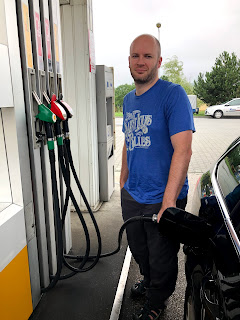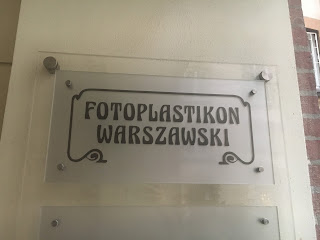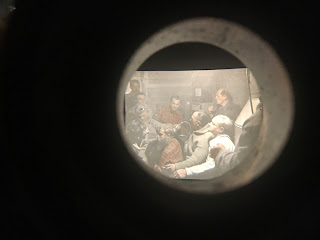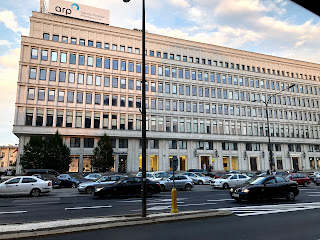[Lydia wrote this one while I was driving her across creation.]
We had a lot of sights to see and not a lot of time to do it, so our day started early. We usually choose to walk rather than take public transportation because it gives us a good feel for the city, and we get to see fun things along the way.
[Jet lag came in handy because we woke up so early that we could hit a lot of the most touristy spots before they were teeming with douchebags.]
Our first fun stop was a street vendor stall to purchase an obwarzanek. Imagine a pretzel and a bagel having a baby. Now imagine the baby is ring-shape. That’s an obwarzanek. We had a choice of several different varieties, and I made a bad choice. I guess I was thinking of pretzels and chose one with a lot of salt. Whoopsies.
We had a lot of sights to see and not a lot of time to do it, so our day started early. We usually choose to walk rather than take public transportation because it gives us a good feel for the city, and we get to see fun things along the way.
[Jet lag came in handy because we woke up so early that we could hit a lot of the most touristy spots before they were teeming with douchebags.]
[Some of the Airbnbs thought they were going to provide hand soap but not shower soap. I showed them!]
[I ate the rest of my meat rope from yesterday for breakfast.]
[I gathered more evidence on my theory of the Polish language. "Now let me try to spell lemonade. Lemon...AJCZY. Lemonajczy. There, I did it. Next word."]
We continued towards the town square, creatively named, Rynek Glowny, meaning main square in Polish. According to our guidebook, it’s Europe’s largest medieval square. The highlight is
St. Mary’s Basilica. Every hour on the hour, a little tune is played from the taller of the two towers. Interestingly, the same tune is also broadcast everyday at noon on Polish radio.
St. Mary’s Basilica
Since I screwed up our first obwarzenek order, we bought another one from a vendor on the square. I let John choose this time, and he did a much better job: the salt was replaced with cheese.
Next we walked to Wawel Hill home of Wawel Castle and Wawel Cathedral. Krakow was the royal seat of Poland for quite awhile, until it moved to Warsaw in 1596, but it’s still the place of royal funerals, weddings, etc. The guidebook says to spend at least four hours here to really understand it, but we got places to be, so we settled for a ten-minute walk through. [I tend to understand stuff real fast anyway.]
The Cathedral has a huge, pre-historic animal bone hanging outside the door. Apparently, it was found during excavations on the site, and now it hangs outside of the cathedral for good luck.
We didn’t have time to spend at the Wawel complex because we had a 9 o’clock reservation to visit the museum at Oskar Schindler’s Factory. We watched Schindler’s List a few months ago in preparation, so it was pretty awesome to finally be there in person. The inside of the factory has been transformed into a museum of Polish WWII history. It had a lot of artsy displays and interactive exhibits.
[I had been excited to see the Fotoplastikon since we conceived this trip, and Schindler’s Factory had a poor replica of one. I enjoyed it but I really hoped that the real one would be better.]
My favorite part was the videos giving first-hand accounts and memories of the factory.
[I thought these baby tanks were pretty hilarious so I'll just write out the whole sign that accompanied it:
The TKS tankette - a small Polish reconnaissance tank, armour thickness 3 to 8 mm, armed with a Hotchkiss machine gun model 1925. The crew numbered 2 soldiers.
The TKS was designed in Poland in the 1930s, partially on the basis of a British model. A globally innovative solution used in the tankette was the turning periscope that enhanced its area scanning function.
In 1939, the TKS tankettes formed the bulk of the Polish armoured forces. Their task was to provide reconnaissance and back-up. During the fights in September 1939, the tankettes were also used for infantry support and took part in the fights against German tanks. Due to insufficient armour and armament, they sustained severe damage when confronted with German armoured forces and anti-tank artillery.
Only the TKS tankettes armed with a 20 mm calibre heavy machine gun FK-A model 38 could confront German light tanks on equal terms Unfortunately, before the outbreak of the Second World War very few of them had come into use. Eight TKS tankettes armed with 20 mm HMG served in the 10th Motorized Cavalry Brigade which fought on the territories to the south of Krakow, at the exhibition - a mock-up.]
[This shop window had an interesting sign as well:
Excerpt from a report from Krakow recorded by a German correspondent for the German Radio in the autumn of 1939; property of NAC
Reporter: We are now entering the shop run by Heinrich Hoffmann to ask its owner how long his firm has been in business at this location.
H. Hoffmann: For about six weeks now. Our activity on the territory of former Poland began already on 3rd September; we left Katowice that day, staying close to the fighting German units. We were traveling by a huge truck, loaded to the brim. Our intention was to provide German clerks and German offices with the possibility to follow the German tradition by hanging Fuhrer's portraits on the walls in their rooms. Yet the situation is somewhat different than we expected. Fuhrer's portraits are also sought after by Krakow's Volksdeutsche, who buy them with much delight. These people were persecuted for such deeds in Polish days.Now, enabled to purchase the longed-for likeness of the Fuhrer, they finally feel free. We considered it our principal duty to provide these people with such possibility, therefore we set off as soon as the Germans captured Katowice.
Reporter: I find it difficult to describe how touched we were when, having passed by so many Polish and Jewish outlets, we finally came across a German shop ornamented with a swastika-bearing flag and a picture of the Fuhrer. Also, I observed the Poles are interested in this shop as well. They gather in groups in front of the window and carefully examine the Fuhrer. It seems to me that it is the first opportunity for the Poles to learn of the character of the man whom they used to know only from caricatures and the anti-German propaganda.
H. Hoffmann: This is why we are doing our best to make our window look attractive at all times. We changes the pictures on display practically on a daily basis to show the Poles what our Fuhrer is like!]
[A bunch of the enamelware that was made in Schindler's factory. He did a lot of shady accounting which allowed him to make much more product than he declared, then use the surplus as bribes.]
We had lunch at a nearby Polish restaurant. John’s been talking about pierogies for the past few days, so we were looking forward to finally having some. Well, unfortunately, we were there too early, and they were still serving breakfast. We settled for Polish sausage and what the menu called strawberry fritters, but were actually more like cottage cheese pancakes with a side of raspberries. It was all real good.
We also took this opportunity to try kvass which is a rye malt drink. It pretty much tasted like it sounds, a rye bread soda. [The menu had this to say: "Traditional East-Slavic, soft drink of live fermentation made according to ancient recipes, exclusively out of natural ingredients, on the basis of rye and barley malt." It cost USD $1.61. What a deal!]
We Ubered back to the Airbnb and hopped in our car to drive to our second Polish stop, Warsaw. We were in a hurry to get to Warsaw’s Fotoplastikon before it closed at six. We learned yesterday that summer in Poland, much like summer in the northern Midwest, is construction season, so our planned driving times are a little off. Other than a stop for gas, we powered through, and made it to Warsaw just in the knick of time. After a slightly stressful drive through rush-hour traffic searching for parking, we finally made it.
[The gasoline situation was a bit confusing at times. Luckily the Poles idiot-proofed this for me by giving different flavors of diesel different shaped nozzles because on at least one occasion I was trying very hard to shove a square peg in a round hole before realizing what the problem was.]
The Fotoplastikon in Warsaw is the only one left in the world in its original location. It’s about a hundred years old and a predecessor of today’s movie. The pictures inside change daily, but the story we saw was of a Polish science expedition. (Amusingly there was a fotoplastikon earlier today in Schindler’s factory, but this one was way better.)
[It's sort of like a giant View-Master that turns the pictures automatically for you.]
[The retro expedition reminded me a whole lot of The Life Aquatic with Steve Zissou.]
The next order of business was finding our Airbnb. It was sort of like a scavenger hunt. First, we had to find the parking, which our silly host didn’t give us an address for. After that, we had two different addresses for the apartment. Well, after a few wrong turns, and a couple of door codes, we made it. We’re traveling geniuses.
We had just a few minutes to chill, and then it was on to the next thing. A Polish man picked us up in a red Soviet-era van to show us around the city. It doesn’t get much more real than that.
[Our guide was very personable. I want to say his name was Wojtk.]
We learned about the Polish hero Jozef Pilsudski who, before becoming a Polish prime minister, robbed a series of Russian banks and trains and consequently spent time doing hard labor in Serbia.
[Polish hero Jozef Pilsudski's sweet ride.]
Next door to his statue was one of the president’s homes. Polish presidents get to choose between two different houses while they’re in power. Currently, the president doesn’t use this home, so it’s used as a guest house for important people. We saw a series of diplomat’s houses and embassies, including the U.S.’s and Russia’s.
[I'm glad our guide pointed out George Washington street because there's no way I would've been able to translate this jumble.]
[This thing was even turning the locals' heads. Our guide said it used to have the water blaster thing still on the top but he got yelled at once for not helping to put out a nearby fire, so then he pried it off.]
The best part of the tour was stopping for some local grub at Pyzy i Flaki Gorące. The food is a leftover from communist Poland when they didn’t have too much food variety. It was basically a mixture of chicken salad and giant gnocchi served in mason jar. It was real good. Our guide told us that back in the day pickles were cheaper than glasses, so people would buy pickles, throw them away, and keep the jar to use as a glass. We washed down our delicious communist meal, with a throwback communist soda.
After that, we drove over the river. Our guide said that he usually takes people down to the banks, but someone lost their pet python recently, and it’s suspected to be hanging out down there. After a few more pictures of the city, we called it a night.





































































































No comments:
Post a Comment